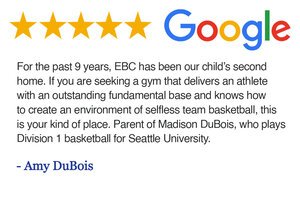EBC Basketball Philosophies
Our culture is like tending a garden. A good gardener uses various mechanical tools, the process is very organic. A good gardener anticipates and prepares for the weather changes, and depending on the environment and what they are growing, they plant, cultivate, and harvest at different times—a systematic without being rigid- a system for operating that offers guidance while being flexible.
5 Pillars of Our Program
1. Love: Build genuine relationships with your players on and off the court with no hidden agendas.
2. Honesty: Love and honesty go hand in hand. If you love them, you’re honest with them. Constructive criticism, affirmation, and encouragement are crucial for helping athletes develop and realize their full potential.
3. Trust: Honesty fosters trust in your relationships with players.
4. Loyalty: Trust cultivates loyalty, motivating players to give their all for you.
5. Work: Effort involving mental or physical exertion to achieve a purpose or result.
All these values work both ways. With love as the foundation, you can navigate both the good and the bad together because of your commitment to one another.
Our 5 Foundational Mental Skills & Language
1. W.I.N. = What’s Important Now
2. Play Present = Be where your feet are
3. Next Play Speed = How fast can you move on and refocus fast
4. Palms Down = Choose your response
5. Victory Goes To The Vulnerable = Comfortable being uncomfortable
T.A.P. = Trust your instinct Accept the outcome Play present
What is our vision?
As we build the foundation of our program, our focus extends beyond this season’s success to ensure the program’s longevity for years to come. Our program will be developed by dedicated, genuine, and intentional coaches who serve as mentors. We aim to prepare our student-athletes for success not only on the court but in all facets of their lives. From our 3rd-grade teams to our high school teams, players will come to know and trust the core values and philosophies of our program. This approach will give them the confidence and preparation needed to realize their highest individual potential and to achieve common goals as a TEAM.
What Kind of Players Are EBC Kids?
1. Selfless Teammates: EBC kids understand the importance of being selfless and working towards a common goal.
2. Continuous Improvement: They recognize that every day is an opportunity to get better.
3. Holistic Growth: EBC kids strive to improve in all aspects of life.
4. Desire for Growth: They embrace the opportunity for improvement, focusing on body language, tone of voice, expanding their knowledge, and becoming the best version of themselves.
We’re Here:
To help our young athletes become the best version of themselves on and off the court and to use the game of basketball to teach life lessons. Coach them hard but love them harder!
“In school, you are taught a lesson and then given a test. In life, you are given a test that teaches you a lesson.” –Buzz Williams
What Is Great Team Culture?
1. Communicate Our Vision: Clearly articulate the team's goals and values.
2. Regular Meetings: Engage regularly with players and parents to maintain open lines of communication.
3. Create Leaders: Foster leadership qualities within the team.
4. Provide Feedback: Offer constructive feedback to support growth and improvement.
5. Promote Learning: Encourage a culture of continuous learning and development.
EBC Development Progression
• Introductory Level (K-2nd Grade): Intro to team principals/concepts while focusing on the fundamentals to build overall motor skills. Avoiding 5 on 5 competition until fundamentals are further developed.
• Foundational Level (3rd-5th Grade): Learning all fundamental basketball concepts. 70% of the time is spent on individual fundamental training and 30% of the time is spent on game competition.
• Advanced Level (6th-8th Grade): Building the engine and consolidating fundamentals. 60% of the time is individual fundamentals and 40% is small games/5 on 5.
• Performance Level (High School): Optimize the engine of skills and performance
EBC Player Development Philosophy
High Clarity = High Performance
Explaining the WHY in everything that we do. In detail coaching them in what they are looking for, where you want to go, what it looks like, and what it looks like when you get there.
EBC Fab 5 skill set absolutes.
1) Ball Handling
2) Footwork (Rip, Pivot & Jabs)
3) Change Pace/Change Direction (Body & Ball Movement)
4) Finishing (4 Solid Finishes: Reach Out, Inside Hand Finish, Jump Stop, Reverse)
5) Shooting (PCS Shooting)
We want to go from good to great in our Fab 5 absolutes. As a program, these 5 skill sets will be replicated in practice and training.
Social Media Workout vs Development Workout
The difference between a social media workout and a development workout comes down to detail in the teaching. A social media workout only requires what is “cool” or what “looks good” and a development workout requires high-level detail and coaching.
EBC Offensive Terminology
95% of the game is played without the basketball.
Introductory & Foundational Level (K-5th Grade) need to understand the following terminology off the ball screens:
Screen away: A type of screen being set after a pass is made, away from the basketball to get a teammate open.
Back screen: A type of screen that is set by an offensive player opposite of the ball and going away from the baseline leading to a direct cut (backdoor) to the basket.
Introductory & Foundational Level (K-5th Grade) need to understand the following terminology screen users:
Curl: A type of movement where an offensive player moves closely around a down screen and cuts towards the basket. A curl occurs when a defender is trailing an offensive player and goes over the down screen.
Backdoor: A type of movement where an offensive player breaks away from a defender and cuts to the basket for a lay-up. A backdoor occurs when a defender is overplaying in the passing lanes and can either be executed off a down screen or a backscreen.
Introductory & Foundational Level (K-5th Grade) need to understand the following terminology screeners:
Pop: A screener pops when the screen user curls or backdoors.
Advanced Level (6th-8th Grade) need to understand the following terminology off the ball screens:
Flare screen: A type of screen where the teammate using the screen fades out to the perimeter to get an open three-point shot.
Advanced Level (6th-8th Grade) need to understand the following terminology screen users:
Pop: A type of movement where an offensive player breaks to the ball for a jump shot.
Flare: A type of movement where an offensive player fades behind a screen and gets to space for a three-point shot. A flare occurs when a defender stays high over the screen and can be executed from either a down screen or a backscreen.
Advanced Level (6th-8th Grade) need to understand the following terminology screeners:
Pop: A screener pops when the screen user curls or backdoors.
We will run a motion offense that will enforce ball movement, player movement (SCREENS), spacing, and playing the game from the inside out. A big emphasis on the 2-second rule. You cannot hold the ball for longer than 2 seconds; you need to shoot it, drive it, or pass it in 2
seconds. Having a clear understanding of giving up good shots for GREAT shots. Valuing each possession and getting the best shot possible. Getting our program to understand less dribbling and more passing will build trust within the team. Our players will be expected to buy into the fact that our field goal percentage as a team will go up when everyone is involved and moving the ball from the inside out.
Screening Breakdown:
4th & 5th Grade: Curl & Pop Backscreen & Pop
6th & 7th Grade: Pop & Slip Backdoor & Pop
8th & 15U: Flare Screen
High School: Freedom
Motion Action Breakdown:
3rd-5th Grade: Pistol & Zipper
6th-8th Grade: C-Screen & Grenade
Defensive Man-to-Man Principles
Every team in our program, from the bottom to the top, will understand that defense is the key to our success. We will primarily play man-to-man defense, emphasizing hard-nosed, tough defense with proper rotations and high basketball IQ.
1. Ball Pressure: Apply pressure on the ball with active hands.
2. No Middle Penetration: Keep the offensive player on one side of the court, shrinking the offense.
3. Gap Defense: When one pass away, be in the gaps.
4. Help Defense: When two passes away, be in the “I” position.
5. Switching: Switch on any guard-to-guard handoffs to keep the offense on one side of the floor.
















